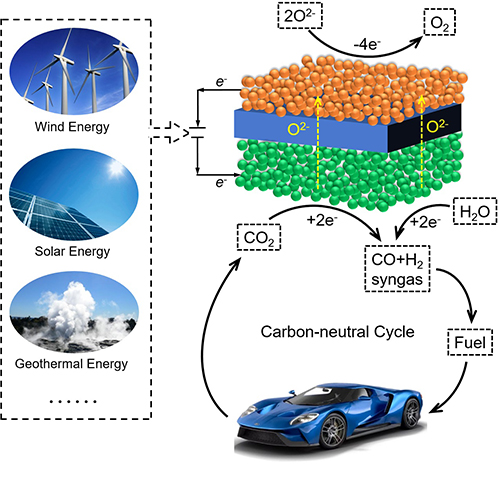Recently, a research group led by Prof. WANG Guoxiong and Prof. BAO Xinhe from the Dalian Institute of Chemical Physics (DICP) of the Chinese Academy of Sciences was invited to review the development, challenges and prospects of high-temperature CO2 electrolysis in solid oxide electrolysis cells. This progress report was published in Advanced Materials (DOI: 10.1002/adma.201902033).
Solid oxide electrolysis cells (SOECs) are able to convert CO2 and H2O to syngas, hydrocarbon fuel at cathode, and pure oxygen at anode. SOECs have the advantages of possessing solid and modular structure, fast reaction kinetics, high energy efficiency and low cost. Therefore, they have promising applications in CO2 conversion and surplus renewable electricity storage.

Carbon‐neutral cycle based on CO2 electrolysis in SOECs. (Image by SONG Yuefeng)
The scientists summarized the development history of SOECs, reaction mechanism of CO2 electroreduction, electrolyte materials and electrode materials. And they introduced the effect of SOEC microstructure on the electrochemical performance, and highlighted the SOEC degradation,the advances of fuel-assisted SOEC and high-pressurized SOEC.
Finally they made a prospect for the future research such as utilizing density in situ physiochemical characterizations to monitor the elementary processes of the electrode reactions and incorporating the alkane conversion at anode of the SOEC to efficiently produce fuel and chemicals.
This research team has dedicated to high-temperature CO2 electrolysis in recent years, and has constructed a series of metal-oxide interfaces by infiltration and in situ exsolution. They increased the amount of surface oxygen vacancies, and promoted the CO2 activation at cathode and oxygen evolution reaction at anode, leading to the enhanced electrochemical performance.
The results of electrochemical impedance spectroscopy, in situ electrochemical X-ray photoelectron spectroscopy and density functional theory calculations revealed that the metal-oxide interface at cathode facilitates the dissociative adsorption of CO2, while the metal-oxide interface at anode triggers the oxygen spillover from oxide to metal surface.
This work was supported by the National Science Foundation of China, the National Key R&D Program of China, and the Strategic Priority Research Program of the Chinese Academy of Sciences. It was dedicated to the 70th anniversary of Dalian Institute of Chemical Physics, Chinese Academy of Sciences. (Text/Image by SONG Yuefeng)